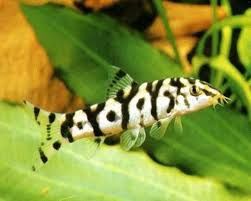Pakistani / Yoyo Loach
Pakistani / Yoyo Loach (Botia almorhae) Care Guide
Also known as the Yoyo Loach
The Pakistani Loach is an active, playful, and colorful bottom-dwelling freshwater fish. Its distinctive black “yoyo” pattern along the golden-orange body and energetic behavior make it a favorite for large community tanks.
Tank Requirements
-
Minimum Tank Size: 150 litres
-
Temperature: 24–28°C
-
pH: 6.5–7.5
-
GH: 5–12
-
KH: 3–8
-
TDS: 150–300 ppm
They thrive in stable, well-oxygenated water with ample swimming space. A soft substrate is recommended to protect their sensitive barbels.
Habitat Setup
Provide an environment that mimics rivers and streams:
-
Soft sand or fine gravel substrate
-
Rocks, caves, and driftwood for hiding and exploration
-
Moderate to dense planting along tank edges
-
Open swimming areas in the middle
They are nocturnal to crepuscular, often more active in low-light conditions or at night.
️ Feeding
Pakistani Loaches are omnivorous bottom feeders:
-
Sinking pellets or wafers
-
Live or frozen foods: bloodworms, blackworms, brine shrimp
-
Blanched vegetables: zucchini, spinach, cucumber
Feed multiple small portions daily, especially in the evening.
Tank Mates
Highly social and playful, they should be kept in groups of at least 4–6 to display natural behavior.
Ideal companions:
Corydoras, Rasboras, peaceful tetras, Guppies, and other non-aggressive species.
⚠️ Behavioral Note: In small groups, Yoyo Loaches can become stressed or show mild aggression toward other bottom dwellers. In proper schools, interactions stay within the group, reducing stress and maintaining a lively tank dynamic.
Breeding
Breeding in home aquariums is rare and not commonly achieved. Most hobbyists purchase captive-bred juveniles from specialist breeders.
Interesting Fact
The name “Yoyo Loach” comes from the black pattern along its body, which resembles the letters “Y-O-Y-O” — and these fish are famous for their energetic, playful antics, often darting rapidly like a spinning yo-yo!
Reference: Bubbly Fish – Creating underwater wonders

